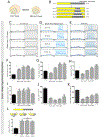A Drosophila model of sleep restriction therapy for insomnia
- PMID: 30824866
- PMCID: PMC6717687
- DOI: 10.1038/s41380-019-0376-6
A Drosophila model of sleep restriction therapy for insomnia
Abstract
Insomnia is the most common sleep disorder among adults, especially affecting individuals of advanced age or with neurodegenerative disease. Insomnia is also a common comorbidity across psychiatric disorders. Cognitive behavioral therapy for insomnia (CBT-I) is the first-line treatment for insomnia; a key component of this intervention is restriction of sleep opportunity, which optimizes matching of sleep ability and opportunity, leading to enhanced sleep drive. Despite the well-documented efficacy of CBT-I, little is known regarding how CBT-I works at a cellular and molecular level to improve sleep, due in large part to an absence of experimentally-tractable animals models of this intervention. Here, guided by human behavioral sleep therapies, we developed a Drosophila model for sleep restriction therapy (SRT) of insomnia. We demonstrate that restriction of sleep opportunity through manipulation of environmental cues improves sleep efficiency in multiple short-sleeping Drosophila mutants. The response to sleep opportunity restriction requires ongoing environmental inputs, but is independent of the molecular circadian clock. We apply this sleep opportunity restriction paradigm to aging and Alzheimer's disease fly models, and find that sleep impairments in these models are reversible with sleep restriction, with associated improvement in reproductive fitness and extended lifespan. This work establishes a model to investigate the neurobiological basis of CBT-I, and provides a platform that can be exploited toward novel treatment targets for insomnia.
Conflict of interest statement
Conflict of Interest
The authors declare no conflict of interest.
Figures





References
-
- Dement W, Pelayo R. Public health impact and treatment of insomnia. Eur Psychiatry 1997; 12: 31s–39s. - PubMed
-
- Ozminkowski RJ, Wang S, Walsh JK. The direct and indirect costs of untreated insomnia in adults in the United States. Sleep 2007; 30: 263–273. - PubMed
-
- Daley M, Morin CM, LeBlanc M, Grégoire JP, Savard J, Baillargeon L. Insomnia and its relationship to health-care utilization, work absenteeism, productivity and accidents. Sleep Med 2009; 10: 427–438. - PubMed
-
- Sarsour K, Morin CM, Foley K, Kalsekar A, Walsh JK. Association of insomnia severity and comorbid medical and psychiatric disorders in a health plan-based sample: Insomnia severity and comorbidities. Sleep Med 2010; 11: 69–74. - PubMed
-
- Qaseem A, Kansagara D, Forciea MA, Cooke M, Denberg TD, Barry MJ et al. Management of chronic insomnia disorder in adults: A clinical practice guideline from the American college of physicians. Ann Intern Med 2016; 165: 125–133. - PubMed
Publication types
MeSH terms
Grants and funding
LinkOut - more resources
Full Text Sources
Medical
Molecular Biology Databases

